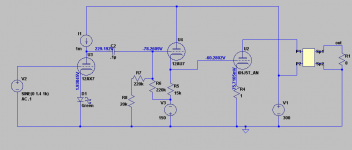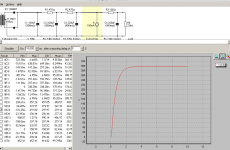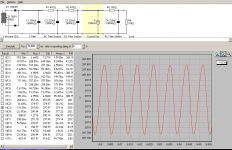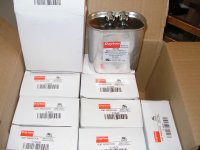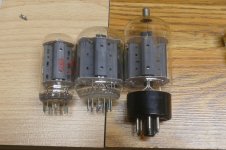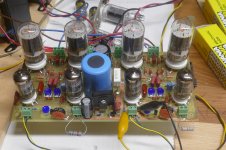Slooooooooowly making progress on my amp. I have a "Maida" regulator but need to move my whole layout around if I want to use it, and or get a bigger enclosure.
I was mainly using the regulated supply for PSRR but with my current power transformer I have enough voltage to use some heavy duty 50 watt resistors in a RCRCRC filter. I have 450 volts to play with and only need <325. This is a single ended class A amplifier so the current draw should remain fairly constant right? I do not want any compression with this amp. The other option is getting a choke but i would have to change my layout again and spring the $$ for one. I am cheap and already have the regulator.
So here is my dilemma;
1) Because it's class A just leave it alone and leave the current RCRCRC filter that drops 140 volts. It's kinda overkill but I can't measure ripple at the last node so I think it's less than 1mV.
2) Make room for the regulator and a heatsink which means change my layout and get a bigger chassis. I was trying to save money and use a small chassis I had on hand but if it's going to make a drastic change in performance I don't mind.
3) Get a choke. This would mean a complete rethink on the power supply because I have too much voltage. This is my last option and least favorite.
What would you do?
I was mainly using the regulated supply for PSRR but with my current power transformer I have enough voltage to use some heavy duty 50 watt resistors in a RCRCRC filter. I have 450 volts to play with and only need <325. This is a single ended class A amplifier so the current draw should remain fairly constant right? I do not want any compression with this amp. The other option is getting a choke but i would have to change my layout again and spring the $$ for one. I am cheap and already have the regulator.
So here is my dilemma;
1) Because it's class A just leave it alone and leave the current RCRCRC filter that drops 140 volts. It's kinda overkill but I can't measure ripple at the last node so I think it's less than 1mV.
2) Make room for the regulator and a heatsink which means change my layout and get a bigger chassis. I was trying to save money and use a small chassis I had on hand but if it's going to make a drastic change in performance I don't mind.
3) Get a choke. This would mean a complete rethink on the power supply because I have too much voltage. This is my last option and least favorite.
What would you do?
Could you bring us up to date by posting the latest schematic? For class A, I would go with the first PS option, should work well enough unless you have super sensitive speakers.Slooooooooowly making progress on my amp.
Could you bring us up to date by posting the latest schematic? For class A, I would go with the first PS option, should work well enough unless you have super sensitive speakers.
That does not sound unreasonable at all
Please point out any gross mistakes. R8 is a 50k bias trimpot. OT is 3k:8 Simulation shows 9w out @ 2.5% THD
Attachments
Very zen... Does the current source on U3 just simulate a CCS?
Yes, I am certain in real life the distortion will increase with the actual CCS used. I have ordered some IXCP10M45S but not too sure if they will work at 1mA. I was going to start with 3.3k for the adjustment resistor and work down, if I have to run the 12AX7 a little hotter I will, maybe 1.4mA. If the IXCP10M45S doesn't work out I will use some depletion mode mosfets, DN2450?
)I chose a 12AX7 and 12AU7 (I know how much everyone hates them
Many 12AU7's do suck, but there are a few good ones. They are often hit or miss even with a bunch of the same brand. Not a real issue in a guitar amp, but some have high distortion no matter what you load them with.
The 12AX7 with a CCS load makes a nice clean voltage amp with lots of gain regardless of anyone's opinion. It needs a light load, like a CCS and a follower. I tend to prefer a mosfet, so don't be afraid to stuff a mosfet into the 12AU7's socket for a comparison. In this circuit the only change needed is a tweak of the bias pot to compensate for the +4 volts gate to source voltage instead of -2 or so for the 12AU7.
Are you going to use a 6HJ5 or a 6GE5 for this amp? Don't know if I will have any breadboard time before you have this thing built. My tube time has gone to zero again......I think I had a 6HJ5 stuck in the socket last time I had it powered up.
I have 450 volts to play with and only need <325.
The string of resistors in the power supply will work, but your transient response is now highly dependent on the quality of the last cap in the power supply. The AVERAGE current in an SE amp remains nearly constant until near clipping, and the peak current demands with a sine wave will vary from zero to 2 X the idle current into a resistive load.
Real music into a speaker load can impose much higher peak currents on transients into a real speaker load, especially with a sweep tube since it has a very high peak current capability. Use a low ESR / ESL film cap for the last cap, or at least parallel the electrolytic with a good film cap.
SSE builders have learned that a motor RUN (not start) cap across (or in place of) the last electrolytic improves the transients and bass response of most systems.
Hey Tubelab, cool idea to stuff a mosfet in the socket and rebias for comparative purposes. I know nothing beats a mosfet for this application. I do not have a distortion analyzer but might be able to have access to one. If the results are poor with the 12AU7 I will try a mosfet or another tube.
I am going with a 6HJ5, it's what I have the most of and I will get more power than with the 6GE5. I should probably just start another thread dedicated to this amp.
As for the last capacitor in the string C3, it's hard to find the ESR for caps I am finding. They are making me do math to figure it out which I am not that great at :/
I found this at mouser; http://www.mouser.com/ds/2/88/SF-14810.pdf They aint cheap! It says dissipation factor is <.1% If ESR=Df*Xc then for a 100uF cap it has an ESR of 1.3. Not that great. The caps I have been using are Nichicon GU and I calculated their ESR to .9 ohms. I will keep searching for some good caps I guess.
I am going with a 6HJ5, it's what I have the most of and I will get more power than with the 6GE5. I should probably just start another thread dedicated to this amp.
As for the last capacitor in the string C3, it's hard to find the ESR for caps I am finding. They are making me do math to figure it out which I am not that great at :/
I found this at mouser; http://www.mouser.com/ds/2/88/SF-14810.pdf They aint cheap! It says dissipation factor is <.1% If ESR=Df*Xc then for a 100uF cap it has an ESR of 1.3. Not that great. The caps I have been using are Nichicon GU and I calculated their ESR to .9 ohms. I will keep searching for some good caps I guess.
it's hard to find the ESR for caps I am finding. They are making me do math to figure it out which I am not that great at :/
Those particular caps are the polypropylene motor run caps used in air conditioning compressors. They are exactly what you want since they are designed to pass several amps of AC current continuously forever. They are also directly connected to the 240 volt or higher AC line and must be able to eat whatever surge comes along. The ESR on these are usually in the low milliohms.
I don't know what the price is on the one you are looking at, but I have usually been able to get surplus parts on Ebay for less than $20 each. I found some ASC 100 uF 370 VAC caps on Ebay several years ago for $15 each so I got 10. A 370 VAC cap can eat 450 volts or more of DC. I put one in an amp that runs about 460 volts of B+ and sees over 500 volts at startup. There have been no issues.
You want a motor RUN cap in a metal (usually aluminum) can, not a start cap in a plastic can. The start cap is actually an electrolytic, and is only used for a fraction of a second at start up. Beware of any black colored cap since some unscrupulous sellers will sell start caps as run caps. They are not made for continuous use and will eventually fail, sometimes violently!
I couldn't find and ASC's but I did find these:
Run Capacitor 100 MFD uf 370 440 V Vac Volts Round AC Electric Motor HVAC | eBay
50 MFD 370V Round AC Electric Motor Run Capacitor HVAC 370 Vac V Volts 50 Uf | eBay
Run Capacitor 50 MFD uf 370 440 V Vac Volts Oval AC Electric Motor HVAC | eBay
There are polypropylene caps made specifically for replacing electrolytics in high reliability applications. Some of them can be pricey but can again sometimes be found surplus. I got some that are called unlytics from a member here in the swap meet section a few years ago. They will go in the "big one" that I will be building someday, since they are rated for 900 and 1200 volts. My B+ will be around 700 volts at 2 amps!!!!
My B+ will be around 700 volts at 2 amps!!!!
You sir like your power
SFT37S100K391B Cornell Dubilier - CDE | Mouser
The cap from mouser is $43 bucks and it's non-stocked.
The links you provided are great so thank you. BUT I just had an idea. We used to build, maintain and repair wastewater pump stations at the generator company I worked at back in the day. They have a whole warehouse full of awesome stuff! I am thinking the motor run caps for the pumps will be better than the ones for air conditioners in terms of current handling capability. The lower the dissipation factor the lower the ESR.
Thanks again for the great tip on using motor run caps, I would have never thought of that.
I went and picked up the caps today and man these things are BIG! Still 10 for $50 I think I did okay  I will probably just use regular aluminum lytic's up until the last cap feeding the output transformer, then I will parallel two of these monsters for 90uF.
I will probably just use regular aluminum lytic's up until the last cap feeding the output transformer, then I will parallel two of these monsters for 90uF.
How much filtering is adequate? I am using a 3k:8 output transformer and the 6HJ5 Rp=450'ish. What sort of ripple should I aim for at the last cap? I was shooting for <10mV. Is that overkill? I use high efficient speakers and don't want any hum.
How much filtering is adequate? I am using a 3k:8 output transformer and the 6HJ5 Rp=450'ish. What sort of ripple should I aim for at the last cap? I was shooting for <10mV. Is that overkill? I use high efficient speakers and don't want any hum.
Attachments
rare triode equivalent
Hi,
this concerns a single ended vacuum tube power amplifier, with a S6 triode driving the 300B output triode.
The S6 is a direct heated triode, was made by Elektromekano, filament 4V, 1A.
As the S6 is becoming very rare, is there a possibility to replace it with another triode with about the same data?
Best regards, Frans.
Hi,
this concerns a single ended vacuum tube power amplifier, with a S6 triode driving the 300B output triode.
The S6 is a direct heated triode, was made by Elektromekano, filament 4V, 1A.
As the S6 is becoming very rare, is there a possibility to replace it with another triode with about the same data?
Best regards, Frans.
When I was quite young I had created a guitar amp design that was basically a Fender Champ with a 6BQ6GT TV sweep tube in place of the 6V6 and a bit more B+. It rocked and was quite loud. Note that the 6BQ6 and the 6DQ6 have the same pinout as the usual 6V6 and 6L6 types except that the plate is connected to a cap on the top of the tube. Note, these are NOT electrically equivalent to any of the common audio tubes, but that didn't stop a 12 year old kid from making (and blowing up) guitar amps. 6V6 and 6L6 types were rare, and cost money, but 6BQ6's and 6DQ6's were free, from inside a discarded TV set, which were quite common in the early 60's.
Of course I didn't understand little things like bias or impedance, bit I never understood why the amp was quieter and tended st smoke when I plugged in the bigger 6DQ6 tube. Years later I would figure all that stuff out......
Now much later I have revisited some of those tubes from my youth, the old TV tubes, and the then dirt common 807's, which I never knew at time WERE 6L6GB's in disguise.
I also found out by cracking open a few, then looking them up, that these 3 tubes contain exactly the same guts. The little ones just have smaller wings on their plates. The little guys ROCK too.....that board makes 75WPC!!!!
The little guy is a 6GF5's, the middle tube is a 6GE5's and the tall guy is a 6DQ6.
Of course I didn't understand little things like bias or impedance, bit I never understood why the amp was quieter and tended st smoke when I plugged in the bigger 6DQ6 tube. Years later I would figure all that stuff out......
Now much later I have revisited some of those tubes from my youth, the old TV tubes, and the then dirt common 807's, which I never knew at time WERE 6L6GB's in disguise.
I also found out by cracking open a few, then looking them up, that these 3 tubes contain exactly the same guts. The little ones just have smaller wings on their plates. The little guys ROCK too.....that board makes 75WPC!!!!
The little guy is a 6GF5's, the middle tube is a 6GE5's and the tall guy is a 6DQ6.
Attachments
- Status
- This old topic is closed. If you want to reopen this topic, contact a moderator using the "Report Post" button.
- Home
- Amplifiers
- Tubes / Valves
- 6GE5 Triode
